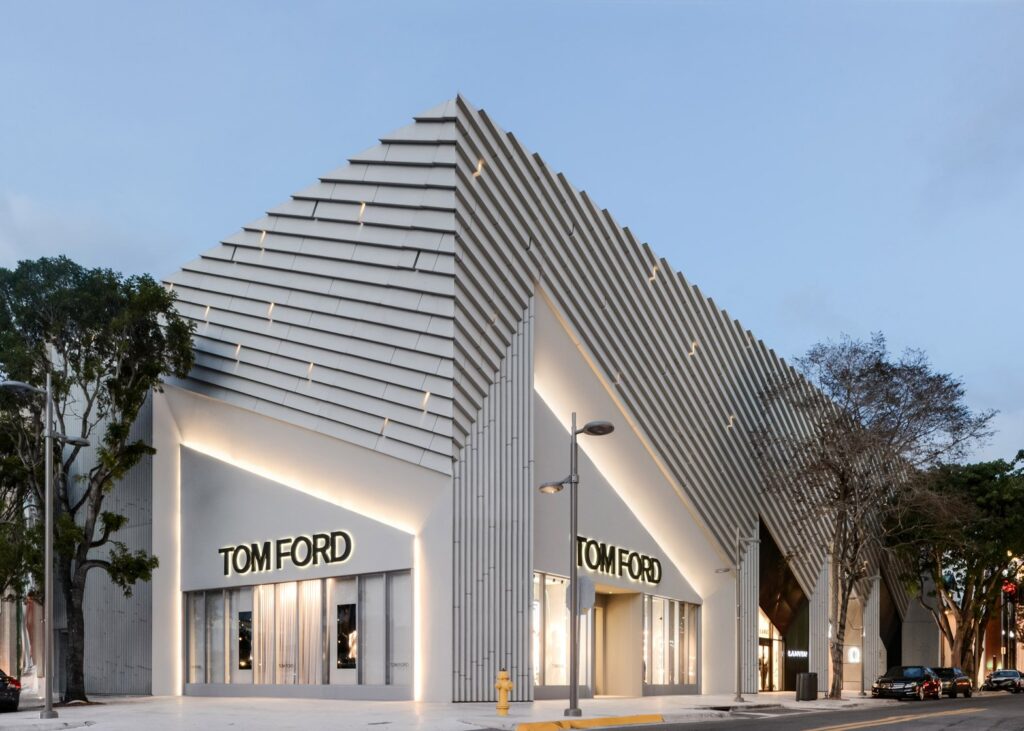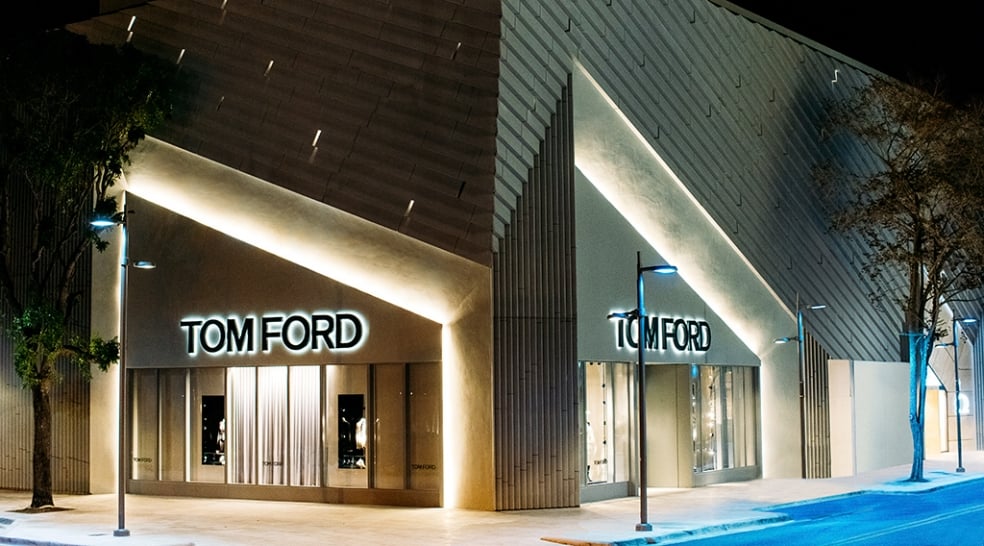The Tom Ford brand stands as an illustrious icon in the realm of high-end fashion, epitomizing luxury, sophistication, and timeless elegance. Founded by the visionary designer and creative genius, Tom Ford himself, the eponymous brand has become synonymous with impeccable craftsmanship, daring designs, and a profound understanding of contemporary style. From its inception to its present-day stature, Tom Ford has managed to revolutionize the fashion industry and redefine the standards of modern luxury.
Tom Ford is a luxury fashion house founded by American fashion designer Tom Ford in 2005. The brand’s product line features ready-to-wear and made-to-measure offerings, as well as footwear, accessories, and handbags.
Tom Ford is known for its high-quality, sexy, and sophisticated designs. The brand’s aesthetic is often described as “glamorous minimalism”. Tom Ford’s products are popular among celebrities and fashion icons, and the brand is also known for its high-profile advertising campaigns.
Tom Ford was born in Austin, Texas in 1961. He studied interior design at Parsons School of Design in New York City, and then worked as an in-house designer at Perry Ellis and Cathy Hardwick. In 1990, he joined Gucci as a designer, and was eventually promoted to creative director of the brand.

Under Ford’s leadership, Gucci became one of the most successful fashion brands in the world. He is credited with reviving the brand’s image and making it relevant to a younger audience. Ford left Gucci in 2004 to launch his own eponymous brand.
The Tom Ford brand has been very successful since its launch. The brand has won numerous awards, including the CFDA Award for Designer of the Year. Tom Ford’s products are sold in luxury department stores and boutiques around the world.
In 2023, The Estée Lauder Companies Inc announced that it completed its acquisition of the TOM FORD brand and is now the sole owner of the TOM FORD brand and all its intellectual property.
Here are some of the key aspects of the Tom Ford brand:
Luxury: Tom Ford is a luxury brand, and its products are priced accordingly. However, the brand’s products are also known for their high quality and craftsmanship.
Sexiness: Tom Ford’s designs are often described as sexy and sophisticated. The brand’s advertising campaigns are also known for their sensuality.
Sophistication: Tom Ford’s designs are also known for their sophistication. The brand’s products are often simple and understated, but they are always elegant and stylish.
Celebrity appeal: Tom Ford is a popular brand among celebrities. Many celebrities wear Tom Ford’s designs, and the brand has also collaborated with celebrities on limited-edition collections.
Founding History of Tom Ford
The inception of the Tom Ford brand is intertwined with the remarkable journey of its visionary founder, Tom Ford, who revolutionized the fashion industry with his audacity, creativity, and unwavering commitment to excellence. Born on August 27, 1961, in Austin, Texas, Thomas Carlyle Ford, known as Tom Ford, exhibited an early interest in fashion and design, setting the stage for a career that would leave an indelible mark on the world of luxury fashion.
Formative Years and Educational Background
Tom Ford’s passion for fashion was evident from a young age, and he pursued his interest by studying art history at New York University. In 1986, Ford furthered his education by enrolling in the prestigious Parsons School of Design, where he honed his skills and refined his creative vision. After completing his studies at Parsons, Ford moved to Paris to immerse himself in the world of fashion and worked as an intern at the renowned fashion house Chloé.
Career at Gucci: The Turning Point
Ford’s career trajectory experienced a significant turning point when he joined Gucci in 1990 as the brand’s chief women’s ready-to-wear designer. At the time, Gucci was facing financial difficulties and was on the verge of bankruptcy. However, Ford’s remarkable talent and innovative approach breathed new life into the brand.
Within a short span of time, Tom Ford’s daring designs and keen eye for aesthetics catapulted Gucci to international acclaim. He introduced a bold, provocative, and sexy style that resonated with the fashion-conscious elite of the 1990s. His contributions led to the revival of Gucci’s fortunes, transforming it from a struggling label into a powerful and influential luxury fashion house.
The Gucci Group and Yves Saint Laurent
As Ford’s success at Gucci continued to soar, he was appointed as the creative director of the entire Gucci Group, which included Yves Saint Laurent (YSL). In 1999, the Gucci Group acquired YSL, and Ford assumed the role of creative director for YSL as well. Under his guidance, YSL experienced a renaissance, blending Ford’s signature sensuality with the elegance and heritage of the YSL brand.
The Birth of the Tom Ford Brand
After a highly successful tenure at Gucci and YSL, Tom Ford parted ways with the Gucci Group in 2004 due to creative differences with the parent company, Pinault-Printemps-Redoute (now known as Kering). However, this departure marked the beginning of an exciting new chapter in Ford’s career as he decided to launch his eponymous brand, “Tom Ford,” in 2005.
With his legendary status in the fashion world, Tom Ford attracted considerable attention and anticipation for his brand’s launch. He aimed to create a fashion empire that would embody his distinctive aesthetic, luxurious craftsmanship, and cinematic allure, empowering individuals through his creations.
Success and Diversification
The Tom Ford brand was an instant hit, quickly establishing itself as a prominent force in the world of luxury fashion. The brand’s iconic collections, ranging from ready-to-wear clothing to accessories, eyewear, fragrances, and cosmetics, garnered praise for their sophistication and provocative appeal. Each piece bore the unmistakable mark of Tom Ford’s daring and elegant design philosophy.
Over the years, Tom Ford expanded his brand’s presence worldwide, opening flagship stores in major fashion capitals and expanding its product offerings. His fragrances, in particular, became wildly successful, capturing the essence of the Tom Ford brand and further solidifying its position as a global luxury phenomenon.
Legacy and Impact
Tom Ford’s brand has left an indelible legacy on the fashion industry, inspiring a new generation of designers and setting new standards of excellence in luxury fashion. Beyond his contributions to design, Ford’s fusion of fashion and film has reshaped the way fashion houses approach branding and storytelling. By empowering individuals to embrace their unique identity and fostering a sense of confidence, the Tom Ford brand has become synonymous with self-expression and bold individuality.
Marketing Strategies of Tom Ford
Tom Ford’s eponymous brand is renowned for its exceptional marketing strategies that seamlessly blend art, sensuality, and aspiration to create a world of luxury and desire. With Tom Ford’s creative vision at the helm, the brand has mastered the art of storytelling and brand positioning, fostering an aura of exclusivity and desirability that captivates its audience. Here are some key elements of Tom Ford’s marketing strategies:
Artistic and Cinematic Campaigns:
An artistic and cinematic campaign is one where the brand leverages creative storytelling techniques such as filmmaking and photography to communicate its message and values.
In the case of the Tom Ford brand, this type of campaign typically involves producing high-quality short films or commercials featuring models, actors, and other personalities wearing the latest fashion designs while engaging in dramatic or whimsical scenarios.
These films often have a distinctive visual style and tone that reflects the brand’s luxurious and sophisticated image. They may feature iconic landmarks, exotic locations, or futuristic settings to evoke a sense of glamour and exclusivity.
Additionally, the campaign might involve collaborations with renowned artists, photographers, and directors to ensure that each piece of content aligns with the brand’s vision and captures the attention of its target audience.
Overall, an artistic and cinematic campaign is designed to convey the essence of the brand and connect with consumers on an emotional level by telling compelling stories through beautiful images and powerful narratives.
Celebrity Endorsements and Influencers:
Celebrity endorsements and influencers are two of the most popular marketing strategies used by the Tom Ford brand.
Celebrity Endorsements
Tom Ford has partnered with a number of celebrities to endorse its products. Some of the most notable celebrity endorsers of Tom Ford include Beyoncé, Rihanna, and Ryan Gosling. These celebrities are all well-known and respected, and they help to give the brand a sense of luxury and exclusivity.
Tom Ford often uses celebrity endorsements in its advertising campaigns. These campaigns often feature the celebrities wearing Tom Ford products and talking about how much they love the brand. This helps to create a positive association between the brand and the celebrities, which can lead to increased sales.
For example, in 2017, Tom Ford partnered with Beyoncé to launch a limited-edition fragrance called “Black Orchid”. The fragrance was a huge success, and it helped to boost sales of Tom Ford’s other products.
Influencers
In addition to celebrity endorsements, Tom Ford also uses influencers to market its products. Influencers are people who have a large following on social media, and they often use their platforms to promote products that they love.
Tom Ford has partnered with a number of influencers, including Chiara Ferragni, Aimee Song, and Olivia Palermo. These influencers have helped to introduce Tom Ford’s products to a wider audience, and they have also helped to create a sense of excitement and anticipation around the brand.
For example, in 2018, Tom Ford partnered with Chiara Ferragni to launch a limited-edition lipstick collection. The collection was a huge success, and it helped to boost sales of Tom Ford’s other products.
Celebrity endorsements and influencers are both effective marketing strategies that can help to increase brand awareness, boost sales, and improve the brand image. Tom Ford has been very successful in using these strategies, and it is one of the reasons why the brand has become so popular around the world.
Embracing Sensuality and Sexuality:
Embracing sensuality and sexuality is a key marketing strategy of the Tom Ford brand. The brand’s advertising campaigns often feature images that are considered to be sensual or sexual, and the brand’s products are often designed to be both luxurious and seductive.
This marketing strategy is based on the idea that consumers are drawn to brands that they perceive as being sexy and alluring. By using sensual and sexual imagery in its advertising campaigns, Tom Ford is able to create a sense of mystery and intrigue around the brand, which can make it more appealing to consumers.
For example, one of Tom Ford’s most famous advertising campaigns featured a photo of a woman wearing a black lace bodysuit and high heels. The photo was highly sensual and provocative, and it helped to solidify Tom Ford’s reputation as a brand that is not afraid to embrace sexuality.
Another example of Tom Ford’s use of sensuality in marketing is its fragrance advertising campaigns. The brand’s fragrances are often named after sexual terms, such as “Black Orchid” and “Narciso Rodriguez for Her”. The fragrances themselves are also designed to be sensual and seductive, with notes of musk, amber, and vanilla.
The use of sensuality and sexuality in marketing can be a very effective way to reach consumers. However, it is important to use this strategy carefully. If the imagery is too explicit, it can backfire and alienate consumers. It is also important to make sure that the imagery is relevant to the brand’s target audience.
Tom Ford has been very successful in using sensuality and sexuality in marketing. The brand’s advertising campaigns are often talked about and shared on social media, and they help to generate a lot of buzz around the brand. This marketing strategy has helped to make Tom Ford one of the most successful fashion brands in the world.
Product Diversification and Licensing:
Product diversification is the process of expanding the range of products that a brand offers. This can be done by adding new product categories, such as fragrances, eyewear, or cosmetics. It can also be done by expanding the range of products within a category, such as by offering different styles of handbags or shoes.
Tom Ford has used product diversification to great effect. The brand now offers a wide range of products, including clothing, accessories, fragrances, eyewear, and cosmetics. This has helped the brand to reach a wider audience and to generate more sales.
Licensing is the process of allowing another company to use the brand name and logo in exchange for a fee. This can be a very effective way to expand the reach of a brand and to generate new revenue streams.
Tom Ford has licensed its brand name and logo to a number of companies, including eyewear manufacturer Marcolin, fragrance company Estée Lauder, and cosmetics company Marc Jacobs Beauty. This has helped the brand to reach a wider audience and to generate more sales.
Both product diversification and licensing are effective marketing strategies that can help brands to achieve success. However, it is important to use these strategies carefully. If done incorrectly, they can backfire and damage the brand image
Experiential Marketing:
The Tom Ford brand has been very successful in using experiential marketing. Some of the brand’s most notable experiential marketing campaigns include:
- Tom Ford Private Cinema: In 2016, Tom Ford opened a private cinema in New York City. The cinema was designed to provide a luxurious and exclusive experience for guests. The cinema was only open for a limited time, but it generated a lot of buzz for the brand.
- Tom Ford Beauty Lab: In 2018, Tom Ford launched a beauty lab in Los Angeles. The beauty lab was designed to give consumers a hands-on experience with the brand’s cosmetics. The beauty lab was also a great way for the brand to collect feedback from consumers.
- Tom Ford Social Club: In 2019, Tom Ford launched a social club in London. The social club was designed to be a space for consumers to connect with the brand and with each other. The social club hosted a variety of events, such as fashion shows, product launches, and networking events.
These are just a few examples of how Tom Ford has used experiential marketing to great effect. The brand’s experiential marketing campaigns have helped to create a sense of excitement and anticipation around the brand, and they have also helped to build brand loyalty.
Flagship Store Design:
The Tom Ford brand has been very successful in using flagship store design. The brand’s flagship stores are known for their luxurious and sophisticated design. They are often located in prime retail locations, and they are designed to create a sense of exclusivity.
Here are some of the key elements of Tom Ford’s flagship store design:
Luxurious materials: Tom Ford’s flagship stores use luxurious materials, such as marble, leather, and crystal. These materials create a sense of opulence and exclusivity.
Sophisticated design: Tom Ford’s flagship stores are designed with a sophisticated aesthetic. The stores are often minimalist in design, and they feature clean lines and simple shapes.
Exclusive products: Tom Ford’s flagship stores often feature exclusive products that are not available in other retail channels. This creates a sense of exclusivity and desirability.
Personalized service: Tom Ford’s flagship stores offer personalized service to customers. The staff is knowledgeable about the brand’s products, and they are able to help customers find the perfect products for their needs.
Tom Ford’s flagship store design is a key part of the brand’s marketing strategy. The stores help to create a sense of luxury and exclusivity, which appeals to the brand’s target audience. The stores also help to build brand awareness and to drive sales.

Limited Editions and Collaborations:
Tom Ford releases limited edition collections periodically, which may be inspired by a particular theme, event, or celebration. These limited releases generate a sense of urgency among customers, encouraging them to make a purchase before the products sell out.
The limited editions often feature distinctive designs, rare materials, or intricate craftsmanship, making them highly desirable among fashion enthusiasts and collectors. By offering limited editions, Tom Ford creates a feeling of exclusivity, attracting loyal customers who seek to own a unique piece from the brand.
Collaborations with well-known designers or popular brands generate significant buzz and media attention, driving more consumers to the Tom Ford brand. It also opens up opportunities for cross-promotion, where fans of the collaborating brand are introduced to Tom Ford’s offerings, and vice versa.
Examples of Tom Ford’s Limited Editions and Collaborations as Marketing Strategies:
Lip Color Collection for Spring/Summer 2018: In 2018, Tom Ford launched a limited edition Lip Color Collection inspired by the vibrant colors of the spring and summer seasons. The collection featured a range of bold and unique lipstick shades that were available for a limited time only. By creating this limited edition collection, Tom Ford generated a sense of urgency among beauty enthusiasts, encouraging them to purchase the exclusive lip colors before they were no longer available.
Tom Ford’s Collaborative Eyewear Collections: Tom Ford has collaborated with various influential designers and artists to create exclusive eyewear collections. For example, the brand partnered with designer Bajowoo for a limited edition eyewear line that featured edgy and unconventional designs. These collaborations allowed Tom Ford to tap into the streetwear and avant-garde fashion scene, attracting a new and diverse customer base.
Limited Edition Fragrances: Tom Ford is renowned for its luxurious fragrances, and the brand often releases limited edition versions of its best-selling scents. These limited editions may feature unique packaging, exclusive notes, or a new twist on the original fragrance. For example, the Private Blend collection has seen several limited edition releases, enticing fragrance enthusiasts to experience these special variations.
Collaboration with Swarovski: In 2021, Tom Ford collaborated with Swarovski to create a limited edition crystal-encrusted version of the iconic Tom Ford Lip Color. The collaboration added a dazzling touch to the lipsticks, making them highly covetable among beauty and fashion aficionados. The strategic partnership with Swarovski added a touch of opulence and glamour to the lipsticks, garnering attention and interest from a broader audience.
In conclusion, Tom Ford’s marketing strategies are a harmonious blend of art, sensuality, and exclusivity. By infusing its campaigns with cinematic allure, embracing provocative sensuality, and leveraging the power of celebrity endorsements and influencers, the brand has successfully crafted a world of luxury and desire. With a focus on experiential marketing, iconic branding, and product diversification, Tom Ford continues to captivate its audience and solidify its position as a prominent force in the world of high-end fashion.
Marketing Mix of Tom Ford
The marketing mix, also known as the 4Ps (Product, Price, Place, Promotion), is a fundamental marketing concept used by businesses to create a comprehensive strategy for effectively promoting their products or services. For Tom Ford, a luxury fashion brand, each element of the marketing mix is carefully crafted to reinforce its image as a high-end, innovative, and aspirational label. Let’s delve into each component in detail:
Product: Exquisite Designs and Quality Craftsmanship
The product aspect of Tom Ford’s marketing mix revolves around its core offerings, which include:
- Fashion Collections: Tom Ford is known for its impeccably designed fashion collections that encompass ready-to-wear clothing for men and women. Each collection reflects Tom Ford’s signature blend of classic elegance and contemporary boldness.
- Accessories: The brand offers a diverse range of luxury accessories, including handbags, shoes, belts, and scarves, which complement its clothing lines and contribute to a complete luxury lifestyle.
- Fragrances: Tom Ford’s fragrance line, particularly the Private Blend collection, has achieved tremendous success. The brand’s scents are crafted with exceptional attention to detail, and the luxurious packaging reflects the brand’s sophisticated identity.
- Cosmetics and Beauty Products: Tom Ford’s cosmetics line includes high-quality makeup products, skincare, and grooming essentials, emphasizing a sense of luxury and allure.
- Eyewear: The brand’s eyewear collections showcase innovative designs and premium materials, appealing to both fashion-conscious individuals and those seeking functional elegance.
Price: Positioning as a Luxury Brand
Tom Ford positions itself firmly in the luxury segment, and its pricing strategy reflects this positioning. The brand commands premium prices for its products, as customers are willing to pay for the exclusivity, craftsmanship, and the cachet associated with owning a Tom Ford item. The aspirational pricing strategy reinforces the perception of Tom Ford as a brand for the affluent and style-conscious elite.
Place: Selective Distribution and Flagship Stores
The place element of the marketing mix deals with how and where customers can access Tom Ford’s products. The brand adopts a selective distribution strategy, carefully choosing retail partners and locations to maintain its exclusive image. Tom Ford products are primarily available in upscale department stores, luxury boutiques, and dedicated Tom Ford flagship stores, strategically positioned in major fashion capitals worldwide.
The brand’s flagship stores, meticulously designed to embody Tom Ford’s aesthetics, serve as immersive and luxurious environments that elevate the shopping experience. These flagship stores are not just retail spaces but also platforms for the brand to communicate its identity and story to customers.
Promotion: Artistic Branding and Immersive Marketing
Tom Ford’s promotional efforts are characterized by artistic storytelling and immersive experiences. The brand leverages a mix of promotional strategies to captivate its audience:
- Artistic and Cinematic Campaigns: Tom Ford’s advertising campaigns are visually striking and often directed or influenced by Tom Ford himself. These campaigns blur the lines between fashion and art, creating an emotional connection with viewers and reinforcing the brand’s luxury appeal.
- Celebrity Endorsements and Influencer Collaborations: Tom Ford dresses A-list celebrities for red carpet events, generating substantial media coverage and exposure. The brand also collaborates with influential personalities and influencers to extend its reach to a wider audience.
- Experiential Marketing: Tom Ford hosts extravagant fashion shows and private events, inviting influential guests and media representatives. These exclusive experiences generate buzz and word-of-mouth marketing, enhancing the brand’s allure.
- Digital Marketing and Social Media: While maintaining exclusivity, Tom Ford engages with customers through social media platforms and digital channels. The brand shares behind-the-scenes glimpses, captivating content, and exclusive updates, fostering a sense of community among followers.
- Limited Editions and Collaborations: As discussed earlier, limited editions and collaborations generate excitement and exclusivity, enticing customers to seek out these unique offerings.
- Flagship Store Design: Tom Ford’s flagship stores serve as a powerful promotional tool, representing the brand’s identity and luxury positioning.
By skillfully combining these promotional strategies, Tom Ford sustains its aura of luxury and crafts a compelling narrative that resonates with its target audience.
In conclusion, Tom Ford’s marketing mix encompasses exquisite designs, aspirational pricing, selective distribution, artistic branding, and immersive experiences. Through this meticulous strategy, the brand maintains its status as a global luxury icon, captivating fashion enthusiasts and discerning customers alike.
Also Read: The Art of Luxury: Chanel Marketing Strategies and Marketing Mix
To read more content like this, subscribe to our newsletter



